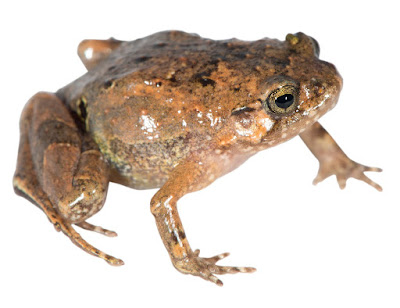 |
| Rhombophryne ellae
Scherz, 2020
DOI: 10.3897/zse.96.51372
|
Abstract
Although taxonomic progress on the frogs of Madagascar is currently proceeding at an unprecedented pace, the goal of completing the amphibian inventory of this hyper-diverse island is still far off. In part this is because more new species continue to be discovered at a high rate, in some cases within well-studied areas. Here, I describe Rhombophryne ellae sp. nov., a new species of diamond frog discovered in Montagne d’Ambre National Park in northern Madagascar in 2017. This new species is highly distinctive in having orange flash-markings on its hindlimbs (not known from any described species of Rhombophryne), and large, black inguinal spots (larger than in all other described Rhombophryne species). It is separated from all named species of Rhombophryne by a substantial uncorrected pairwise distance in the 16S rRNA mitochondrial barcode marker (> 7%) and is most closely related to an undescribed candidate species from Tsaratanana in northern Madagascar. Rhombophryne ellae sp. nov. adds another taxon to the growing list of cophyline microhylids that have red to orange flash-markings, the function of which remains unknown and which has clearly evolved repeatedly in this radiation. The discovery of such a distinctive species within a comparatively well-studied park points toward the low detectability of semi-fossorial frogs and the role of inclement weather in increasing that detectability.
Key Words: Amphibia, Anura, micro-CT, molecular genetics, osteology Rhombophryne ellae sp. nov., systematics, taxonomy
Rhombophryne ellae sp. nov.
Diagnosis: Rhombophryne ellae sp. nov. is assigned to the genus Rhombophryne based on its plump body shape, presence of vomerine and maxillary teeth, curved clavicle, knob-shaped terminal phalanges, and phylogenetic relationships. It is distinguished by the following unique combination of characters: (1) adult or subadult female SVL 24.9 mm, (2) distinctly enlarged inner metatarsal tubercle, (3) absence of superciliary spines, (4) orange flash-markings on its posterior thighs in life, and (5) presence of large and distinct black inguinal spots.
....
Natural history, distribution, and conservation status:
The holotype was collected at 892 m a.s.l. in rainforest on Montagne d’Ambre during the day actively jumping away from trampling feet during moderate to heavy rain brought about by Cyclone Ava. Its gut contents included three whole ants and one ant head, seemingly belonging to two different species (one of the whole ants is diminutive), the head of a jumping spider (Salticidae), and the elytra and other body parts of a beetle. Nothing more is known of the ecology of this species, though it is probable that its reproductive mode and ecology is similar to other litter-dwelling Rhombophryne species (Scherz et al. 2016a). As the species is known from a single individual, its Red List status cannot be confidently estimated. However, the syntopically occurring Stumpffia species have been suggested to be Near Threatened due to their small range and presumed micro-endemicity within a well-protected forest, and this likely applies to R. ellae sp. nov. as well.
Etymology: It is with great pleasure that I dedicate this charming little frog to my partner, Dr Ella Z. Lattenkamp, in appreciation of her love, support, and infinite patience, and in celebration of the completion of her PhD.
Mark D. Scherz. 2020. Diamond Frogs Forever: A New Species of Rhombophryne Boettger, 1880 (Microhylidae, Cophylinae) from Montagne d’Ambre National Park, northern Madagascar. Zoosystematics and Evolution. 96(2): 313-323. DOI: 10.3897/zse.96.51372
Shining like a diamond: A new species of diamond frog from northern Madagascar










